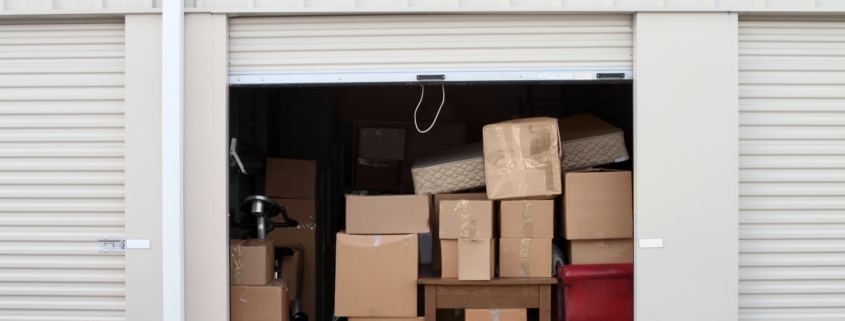The Ultimate Junk Drawer
Is your stuff really worth what it’s costing you to store it? There’s nothing like a couple of episodes of the reality television show Hoarders to make even the biggest clutter bug want to get rid of something.
To be honest, I’ve watched that show just once, and that was enough to last for the rest of my life. Halfway through, I had this uncontrollable urge to clean out a closet.
It crossed my mind that, at least in that one episode, the subject hoarders were living with their stuff, which is more than we can say for the 14.6 million U.S. households that are paying a self storage facility, every month, to store their stuff.
At last count, there were just shy of 52,000 storage facilities across this country―more than three times the number of Starbucks! And within those storage facilities are approximately 17.5 million individual storage units, covering 1.7 billion square feet. One out of every 10 U.S. households now rents a unit to cram a lot of stuff at the average price of $100.32 per month—$1,203.84 each year.
Why is self-storage such a big business?
Human laziness
One facility owner told me that the industry counts on―and even capitalizes on―the fact that once renters move in, they’re in. Facility owners know that no one likes the idea of spending the day moving all their accumulation of stuff out of storage. Of course, there are situations where self-storage may become a necessary expense. However, the operative word should be “temporary,” a stop-gap for a specific period, not permanent.
Procrastination
As long as renters believe that somehow they can afford the rent for just one more month, they’ll leave that stuff in there forever. Besides, it’s charged directly to a credit card, so it doesn’t really feel like spending money.
Entitlement
Face it. The prosperity we’ve enjoyed in this country over the past 20 years has produced lots of extra clothes, sports equipment, toys and vehicles. And it all quickly comes under the heading of “stuff” once the newness wears off.
Frugality gone wrong
Some parents rent storage units to keep toys, sports ger, and clothing for younger siblings after the older ones have outgrown them. This strategy might appear frugal, but it is not very cost-effective. Consider this: You can easily buy a houseful of like-new toys at yard sales or online for less than the cost of storing them.
How to break the storage unit addiction
Dollar value
Figure it out. Everyone thinks their stuff is priceless, but be realistic. If you had a sale tomorrow, how much cash would you get for it? Multiply your storage bill by 12. Is your stuff worth what you’re paying to store it each year?
Enjoyment level
Let’s say you pay this small fortune each year to store stuff you like—your enjoyment level is off the charts. When was the last time you actually thought about those items or took the time to visit? After all, how much can you really enjoy something you have stashed away in an offsite storage unit? Take a photo of all of the things you like so much. Often, it’s the memory you’re looking for. A photo will take care of that, allowing you to get rid of the items themselves.
A two-step plan
If you’re ready to take control of your storage situation, I have two words for you: eliminate and organize. And in that order.
Eliminate
This doesn’t necessarily mean to throw your things into the trash. Although you need to do some of that, eliminate, for our purposes, means to liquidate by exchanging for cash. There are myriad ways to do this, all of which will require time and effort. And for that, you will be paid accordingly.
For things you cannot turn into cash, make a detailed record and then donate them to a thrift store or other collection site. When you itemize your next tax return, you may be able to benefit by deducting the fair market value of these items.
Organize
Look at what you have left once you have pared down as far as possible. These things need to be introduced back into your life so that they are not a burden.
Find a place at home
Even tiny apartments have small spaces here and there that can be turned into storage spots. Organizing gadgets and storage systems, though costly, are often less expensive than several months’ storage fees. Homemade alternatives to storebought organizers are even less expensive.
Stop procrastinating
Perhaps you’ve rented storage space for stuff you’ve inherited. Once you sold your parents’ home, you were just too emotionally exhausted to wade through their possessions. You hauled everything to storage to deal with after the grieving was over. And just how many years has that been? Face it. The family heirlooms are undoubtedly mingled with household junk, and probably more junk than heirlooms. Keep what is truly useful or brings you great joy. Turn the rest into cash so you can go on with your life.
Set a deadline
Make a decision for when you will go through all of those boxes and bins. Tell a friend or relative of your decision, then ask that person to hold you accountable to keep it.














We just helped a friend empty her unit and figured she had spent over $16,000.00 for the stuff. We sold what we could, donated what we could and hauled 4 trailer loads to the dump. She got a little over $200.00 for what we could sell. Not good.
You, Sir, are a good friend!